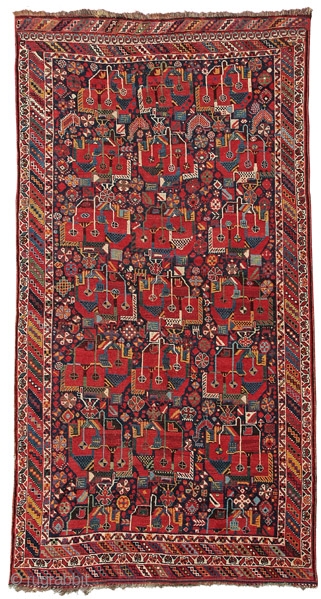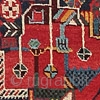Back
Carpet with gol farangh design
Afshar tribe, Sirjan area
Southeast Persia
circa 1870
252 x 147 cm (8’3” x 4’10”)
Alg 2117
symmetrically knotted wool pile on a wool foundation
Afshar tribe, Sirjan area
Southeast Persia
circa 1870
252 x 147 cm (8’3” x 4’10”)
Alg 2117
symmetrically knotted wool pile on a wool foundation
The so-called European flower (gol farangh) pattern has been quite popular in Persia since the Safavid period (1506-1722), gracing the architectural interiors of many mosques from Isfahan to Kerman. It is not surprising therefore to see it employed on some of the most refined weavings of tribal Iran, of which this is a valid representative. The full range of highly saturated dyes employed by the weaver is seen here at its best, further enhanced by the lustrous wool pile and by the impeccable condition. The medium large format is quite rare for this group of Afshar weavings, which is characterised by highly depressed warps and by end skirts woven in the sumakh technique.
http://www.albertolevi.com/products_index.asp?TL=ENG&IDCat=44
price:
POR
- Home
- Antique Rugs by Region
- Category
- Profiles
- Post Items Free
- Albums
- Benaki Museum of Islamic Art
- Budapest: Ottoman Carpets
- Gulbenkian Museum
- Islamic Carpets. Brooklyn
- Islamic Textiles. Brooklyn
- Konya Museum: Rugs
- MKG, Hamburg
- MMA: Caucasian Carpets
- MMA: Mamluk Carpets
- MMA: Mughal Indian Carpets
- MMA: Ottoman Carpets
- MMA: Safavid Persian Carpets
- MMA: Turkmen Rugs
- McCoy Jones Kilims
- Ottoman textiles. Met
- Philadelphia Museum
- Rugs and Carpets: Berlin
- Seljuqs at the Met
- TIEM, Istanbul: Carpets
- V&A: Classical Carpets
- Vakiflar Carpets: Istanbul
- Baluch Rugs: Indianapolis
- Gallery Exhibitions
- Jaf an Exhibition
- Alberto Levi Gallery
- Andean Textile
- Christie's London: 2016
- Francesca Galloway
- HALI at 40
- ICOC Washington, DC 2018
- Jajims of the Shahsavan
- London Islamic Week April, 2018
- Mongolian Felts
- Navajo Rugs: JB Moore
- Persian Piled Weavings
- SF Tribal & Textile Art Show 2020
- SF Tribal 2019
- Sotheby's: C. Alexander
- Turkish Prayer Rugs
- Turkmen Main Carpets ICOC 2007











